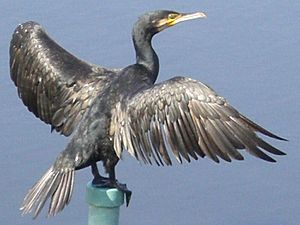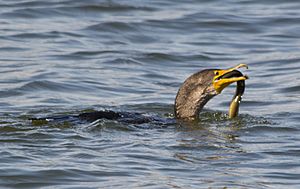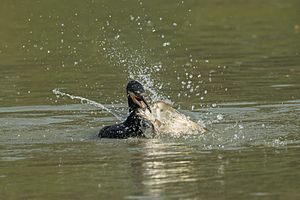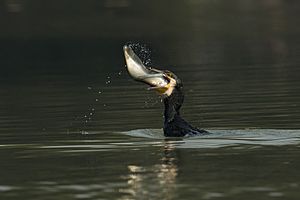Great cormorant facts for kids
The great cormorant (Phalacrocorax carbo) is a type of seabird. It belongs to the cormorant family. This large black bird lives and breeds in many parts of the Old World (Europe, Asia, Africa). It also lives along the Atlantic coast of North America. Great cormorants can be different sizes depending on where they live. They usually weigh between 1.5 kg (3.3 lb) and 5.3 kg (11.7 lb).
Contents
What They Look Like
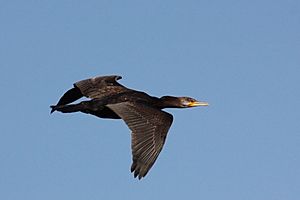
The great cormorant is a big black bird. Its size can vary a lot across its wide range. It is one of the largest types of cormorants. Only the flightless cormorant is bigger. The Japanese cormorant is about the same size.
This bird has a long tail. It also has a yellow patch on its throat. Adult birds have white patches on their thighs during the breeding season. They also have white on their throat. In Europe, you can tell it apart from the common shag. The great cormorant is larger and has a thicker bill. It does not have a crest of feathers. Its feathers also do not have a green color.
In eastern North America, it is bigger than the double-crested cormorant. The double-crested cormorant has more yellow on its throat and bill. It also does not have the white thigh patches. Great cormorants are usually quiet. But they make different low, rumbling sounds at their nesting places.
Rare Variations
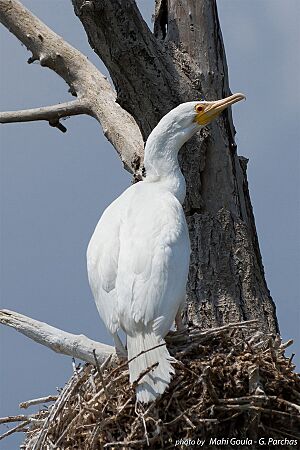
A very rare type of great cormorant is an albino. This means it lacks color. An albino great cormorant often has poor eyesight or hearing. Because of this, it usually cannot survive long in the wild.
Where They Live
This bird is very common and found in many places. It eats fish from the sea, estuaries (where rivers meet the sea), and freshwater lakes and rivers. Birds from northern areas fly south for the winter. They spend winter along coasts that have plenty of fish.
In Serbia, great cormorants live in Vojvodina. After 1945, many artificial lakes were made in Serbia. Some of these lakes became good homes for cormorants. For example, on Lake Ćelije, formed in 1980, there is a group of cormorants. They nest there and stay all year. However, the lake froze completely in January–February 1985 and February 2012. During those times, the birds left.
The main type of great cormorant, P. c. carbo, lives mostly near the Atlantic Ocean. This includes western European coasts and North Africa. It is also found in the Faroe Islands, Iceland, and Greenland. On the eastern coast of North America, it breeds only in the northern parts. This is in the Canadian maritime provinces. Another type, P. c. novaehollandiae, lives in Australian waters.
Life Cycle and Behavior
Reproduction
The great cormorant often builds its nests in groups. These groups are usually near wetlands, rivers, or calm coastal waters. Pairs of birds will use the same nest spot each year. They build their nests from sticks. Nests can be in trees, on cliff ledges, or on the ground of rocky islands. These islands are safe from animals that might eat their eggs or chicks.
A female cormorant lays a clutch of three to five eggs. The eggs are about 63 by 41 mm (2.5 by 1.6 in) in size. They are a pale blue or green color. Sometimes they have a white chalky layer on them. The parents sit on the eggs for about 28 to 31 days until they hatch.
How They Find Food
Great cormorants eat fish that they catch by diving. They mostly eat wrasses. But they also catch sand smelt and common soles. The size of fish they catch changes with the weather. They catch bigger fish when the air and water are colder. For example, they might catch 30 g (1.1 oz) fish in summer. But they might catch 157 g (5.5 oz) fish in a cold winter.
Cormorants dive to catch their food with their beak. Their dives usually last about 28 seconds. They can dive to depths of about 5.8 m (19 ft). About 60% of their dives are to the bottom of the water (benthic zone). About 10% are to the open water (pelagic zone). The other dives are to areas in between.
Cormorants and People
Many fishermen see great cormorants as rivals for fish. Because of this, people hunted them a lot in the past. They were almost wiped out. But thanks to efforts to protect them, their numbers have grown. Today, there are about 1.2 million great cormorants in Europe. As their numbers increase, they sometimes come into conflict with fishing again.
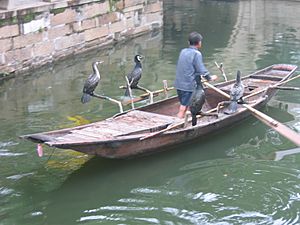
Cormorant fishing is a traditional way of fishing. It is done in China, Japan, and other places. Fishermen tie a line around the cormorants' throats. This line is tight enough to stop the birds from swallowing large fish. The cormorants dive and catch fish. But they cannot swallow them completely. The fishermen then get the fish by gently opening the birds' mouths.
In Norway, the cormorant is a traditional bird for hunting. Each year, about 10,000 cormorants are hunted for food. In North Norway, cormorants are seen as special birds. It is thought to bring good luck if cormorants gather near a village. An old story says that people who die far at sea and whose bodies are never found live forever on an island called Utrøst. Only sometimes can people find this island. The people of Utrøst can visit their old homes by turning into cormorants.
Images for kids
-
An immature great cormorant in Kazinga Channel, Uganda.
-
On Farmoor Reservoir, Oxfordshire.
See also
 In Spanish: Cormorán grande para niños
In Spanish: Cormorán grande para niños


